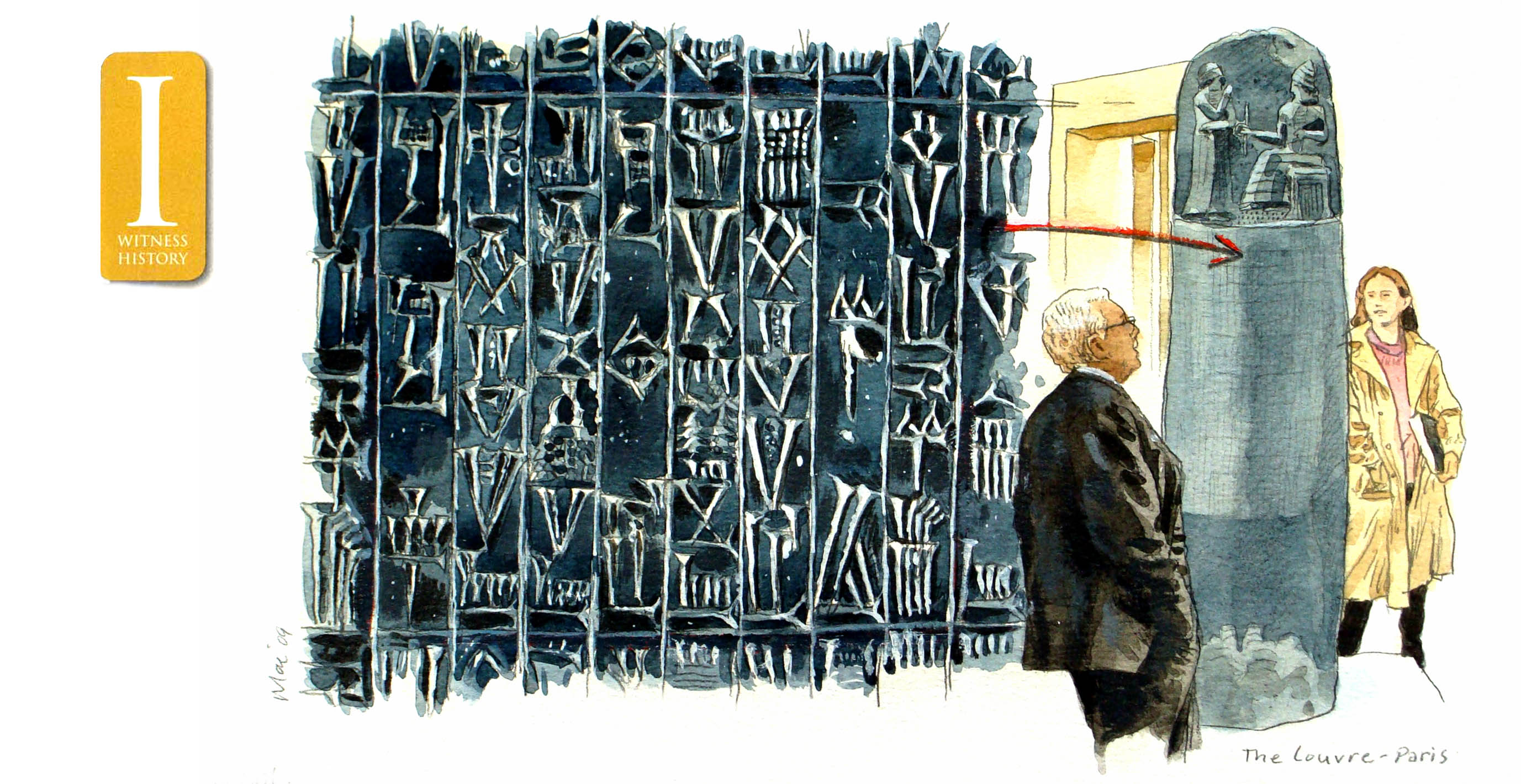
I Witness History: I, Pillar of Justice
At first, you humans used us rocks for fighting and tool-making. Then I evolved, showing how we can actually mediate your incessant quarrels. In Akkadian cuneiform dictated by Hammurapi, my royal Babylonian collaborator, I formed of my stony flesh not weapons, but words; not tools, but rules.
Look at you looking at me.
Your brow wrinkles into lines of cuneiform as your brain races to remember what makes this big black rock the pride of modern Paris. Admit it: You don’t have a clue what basalt really is.
Look at you looking at me.
Your brow wrinkles into lines of cuneiform as your brain races to remember what makes this big black rock the pride of modern Paris. Admit it: You don’t have a clue what basalt really is.
You can’t identify the two figures carved on my face, and I seriously doubt that you can read a word of my ancient Akkadian. You probably arrived at the Louvre, like eight million others every year, more familiar with The Da Vinci Code than with the Code of Hammurapi. Well, c’est la vie, as they say around here. I can fix that—as I have fixed so much else for your struggling species. Now, try again: What should you know about me? Here’s a clue: Rock Rules!
I, Pillar of Justice, mark an evolutionary triumph in the long, long history of stone. Before my time, for hundreds of millions of years, my lithic ancestors managed little more than the shaping and shifting of continents. After several fits and starts, a single-continent Pangaea finally divided itself into the separate land masses of our planet’s present era. Along the way, my forebears learned to fashion themselves into mountains, valleys and vomiting volcanoes. Some made fossils, a magician’s trick of mineralization with no real purpose but to pass the time. Only when rocks perfected the second act—erosion—before an astonished audience—you humans—did our idle fossilizing find true meaning, first as myths about giant men and then as the means to study dinosaurs. Somewhere between Pangaea and paleontology, we cultivated a brief Stone Age during which, for about 2.5 million years, my progenitors taught your progenitors the technology of tools and weapons. Men trusted in stone to capture, kill and carve their prey; to divide and defend their lands with makeshift walls and to arbitrate every dispute with spears and slings.
Then, my kind evolved and changed everything forever. I, Pillar of Justice, Pillar of Strength, showed rock a bolder way to mediate human conflict. I formed of my stony flesh something new: words, not weapons; rules, not tools. Thus, of all the things that rock has become (tabletops, T-Rex, temples, tombs), it is I who am by far the most advanced. On other branches of my phylogenetic tree, you will find obelisks—beautiful but not brainy—striving to be me. I overshadow in mind if not mass both the pyramids and the Parthenon. Mosaics? Dainty little pictures, to be sure, but I have progressed beyond gravel, to gavel. I am, after all, the rock of sages, the world’s most famous code of law.

I arrived on the scene as no more than a giant block of black basalt, a hard igneous rock cooled ages earlier from fiery magma. To save humankind, I took as my partner a member of your species named Hammurapi. (Some of you spell him Hammurabi. Humans cannot agree on anything.) He was a decent man descended from Amorites who had wandered from the western deserts into the little town of Bab-ilim (“Gateway of the God”), which you now call Babylon. In time, the immigrants became kings and, in 1792 BC, Hammurapi, the sixth in their dynasty, succeeded to the rule of their small realm. During his reign of 42 years, the new ruler of Babylon used both battle and diplomacy to extend his power over all of Mesopotamia. He secured his place among the great empire-builders of antiquity making him the envy of such modern-day leaders as Saddam Hussein, who vaunted the “Hammurapi Division” of his Republican Guard and who, as a precondition for oil-export deals, often demanded my return from France. Hammurapi himself had no armored divisions, but his forces more than matched those of his rivals in Elam, Assyria, Larsa and Mari. For the next thousand years, Babylon would be the region’s most renowned city in this new experiment called civilization.

Near the end of Hammurapi’s reign, I made him more illustrious than ever. I, Pillar of Justice, crowned his achievements by publishing a set of laws to govern the lives of his quarrelsome subjects. I was not the first to try this, but my success speaks for itself. All prior attempts by lesser men, using such lesser materials as crumbly clay tablets, show my superiority. Thanks to me, the name of Hammurapi would henceforth and forever be linked with the rule of law—the saving grace of human society. Human, I say specifically, because if you look inside any comparable city built by bees or ants, you will never find a little stone pillar like me listing the rules that maintain insect order. No hive needs a Code of Hammurapi to prevent apiary anarchy. People, I’m afraid, are the problem.

As a lavish prologue, my first section pays homage to Hammurapi and his solicitude for gods and men. Some of what I say here about my partner has the ring of propaganda, I freely admit, but a certain amount of pomp was necessary at the time. This prologue enumerates at length the benefactions made by Hammurapi, “the exalted Prince of Babylon,” to the many deities worshiped in his polytheistic empire. I gush that he enriched temples and cities, increased the harvest, heaped up sacrificial offerings, smote bandits, pardoned enemies, protected slaves and, not least, established peace. I call him “the King of Righteousness” and “the Salvation-Bearing Shepherd” whose mission was “to destroy the wicked, punish evil-doers and ensure that the strong no longer harmed the weak.”
Next comes the important part: a collection of at least 282 legal rulings (di-nat sharim) that constitutes the literal bedrock of judicial history. This is our greatest gift to humankind since the Stone Age. Using mostly conditional “if–then” statements, I answer evil with punishment: “If anyone accuses another of a capital offense but fails to prove his case, then that accuser shall be put to death.” This judgment is among the first five in the code, all dealing right at the start with the serious problem of bearing false witness. After all, any legal system is only as good as the evidence it allows. That is why my fifth ruling fines and removes from the bench any judge whose incompetence leads to a wrongful decision. Following these safeguards for judicial probity, my text then turns to matters of theft, land tenure, leases, loans, wages, family disputes, inheritance, personal injury and professional misconduct. In other words, I tackle the myriad ills arising from the day-to-day drama of people interacting with people.
"Let any person wronged by another bring his case before me, Pillar of Justice ….
Let my laws bring order and put his mind at rest."
Some of what I decree you moderns will find quite familiar, such as my prohibition of incest, adultery, kidnapping and slander. What you might consider exotic, however, are my many rules governing aspects of life no longer commonplace in your world. For example, I have an inordinate amount to say about oxen. What should be done if a person rents an ox and then somehow harms the animal? I list specific judgments for each kind of injury to the beast’s neck, horns, eyes, tail or muzzle, as well as for those extreme cases where, say, the ox is eaten by a stray lion. Conversely, I cover disputes arising when the ox itself does the hurting. (Hint: The whole matter hinges on whether the owner knew his ox was dangerous and took appropriate measures to protect the public.) Dowries, debt slavery and sorcery require my attention, plus the occasional missing plow and defective irrigation ditch. On the subject of grain, I am a virtual encyclopedia.
My laws brim with decisions involving concubines, slaves and the rights of multiple wives within aggregate Mesopotamian families. I refuse to let a husband abandon an ill wife when he marries another, or let a husband sell a slave given to him by a wife once that servant has borne him children. I protect both husbands and wives from debts incurred by their mates before marriage. I put few obstacles in the way of divorce, except for grave concerns about the fair division of property and the welfare of any small children. Meanwhile, what must be done if a woman remarries while her husband is a prisoner of war? How many times must a father forgive a serious fault in his son? Can a prostitute bequeath her inheritance as she pleases? To be honest, I never imagined the amount of trouble humans could make for themselves—and thus for me.
My penalties for misconduct might sometimes astonish you, especially the recurring sentence of death. I execute thieves, liars, harborers of runaway slaves, tavern-keepers who do not arrest conspirators meeting in their establishments and neglectful wives. I must point out that Mesopotamian civilization organized itself into three distinct classes, and the punishments meted out differed accordingly. The awilum (upper class) fared better than the mushkenum (subordinate free class), who in turn enjoyed many obvious social and legal advantages over the wardum (slaves). Between Babylonians of equal rank, I followed the principle of retaliatory justice: An eye for an eye, a tooth for a tooth, a life for a life. But, if an awilum should blind the eye of a mushkenum, then the noble keeps his (more valuable) eye and instead pays a fine to his victim. Injuries to a wardum draw a fine payable to the slave-owner. I allow physicians to charge more for performing the same operation on an awilum than on patients of a lower class, but the consequences for malpractice are commensurately greater: Botch the medical procedure on an awilum and the doctor loses the incompetent hand that held the scalpel. In some rulings, my devotion to reciprocity may appear extreme. For example, when the builder’s shoddy work causes the death of a homeowner’s son, then I decree the death not of the builder but of the builder’s own son in return. Some offenses warrant impaling (for a cheating wife who murders her husband), drowning (for a father caught having sex with his son’s wife), burning at the stake (for incest with your mother), removal of the tongue (for a prostitute’s son impugning his foster parents) or court-ordered mastectomy (for a wet-nurse secretly swapping one child for another). My discipline may seem hard as stone, but I felt compelled to set stern examples at this critical early stage of your social development.

I, Pillar of Justice, put a heavy premium on reliable witnesses and well-written contracts. Still, your ancestors occasionally left me no choice but to resort to trial by ordeal. If, for example, a wife were accused of adultery but was not actually caught in the act, then to remove her from suspicion, I ordered her thrown into the Euphrates. If innocent, she swam to the other side; if guilty, she drowned. This method allowed the gods to determine her fate. Before you protest—I’ve heard it all before—let me remind you that, for a penal system placed under the nominal authority of Shamash, I afford the gods a minimal role in Mesopotamian justice. I am not really a very religious rock, although I do take into account the beliefs and superstitions of those I evolved to help. Whatever your own religion might be, give me credit for the good I have done under difficult circumstances. I set up a system of legal recourse for rich and poor, free and slave. I spelled out a person’s rights and responsibilities. I protected one human from another by declaring: Let any person wronged by another bring his case before me, Pillar of Justice, and heed the judgments inscribed thereon. Let my laws bring order and put his mind at rest.
I protected one human from another by declaring: “Let any person wronged by another bring his case before me, Pillar of Justice …. Let my laws bring order and put his mind at rest. In the final section of my massive cuneiform text, I again praise my partner Hammurapi. Of course, I mention me in this epilogue, too. Mostly, I call down curses upon any who might dare deface me. I warn that the sky-god Anu will destroy the scepter of any king who corrupts my words in any way. I swear that Babylon’s great god Marduk will likewise bring him famine, that incorruptible Shamash will crush his troops, that Sin the moon-god will fill his shortened life with heavy sighs and sorrows, that the storm-god Adad will dry up the rivers and springs, plus all of the usual maledictions about barren wombs, raging fevers, incurable diseases and frightening omens of a dreadful future. On the other hand, I do include a more pleasant promise in the name of the gods that all subsequent rulers who respected me would surely prosper. Call it “good cop–bad cop,” Mesopotamian style.

In December of 1901, one of my fragments emerged from the soil. A few weeks later in 1902, the other half came to light. I had been excavated by a team of archeologists led by the Frenchman Jacques de Morgan. I, Pillar of Justice, was immediately hailed as the most complete code of ancient Mesopotamian laws ever discovered. Scholars eagerly sought in me parallels to the Hebrew Old Testament, even though our similarities do not really run very deep, and they studied scrupulously all I had to say about life in early Babylonia. Naturally, I came to live in the Louvre, surrounded by adoring crowds hard-pressed to notice the 30,000 other objects sharing this ornate palace with me. Granted, many visitors like you may not at first recall everything you should about me, but the light of Shamash soon dawns.
Now, modern-day mushkenum, you may go, but do obey all the posted rules on your way out—NO FLASH PHOTOGRAPHY; DO NOT TOUCH THE ARTWORKS; SMOKING IS PROHIBITED; NO FOOD OR DRINK IN THE GALLERIES—or else I might have to toss you into the Seine, just for old times’ sake. Rock Rules.
This article appeared in the May/June 2009 print edition of AramcoWorld.
About the Author

Frank L. Holt
Frank L. Holt (fholt@uh.edu) is professor of ancient history at the University of Houston as well as founder and director of the Houston Mummy Research Program, to whose members and contributors he expresses his thanks.
Norman MacDonald
When artist Norman MacDonald compared his own brushes, inks and watercolors in his Amsterdam studio to records of those in Egypt as long as 3,500 years ago, he says he “realized again how little the tools of a painter’s craft have changed.”
You may also be interested in...
.jpg?cx=0.5&cy=0.5&cw=480&ch=360)
Photo Captures Kuwaiti Port Market in the 1990s
History
Arts
After the war in 1991, Kuwait faced a demand for consumer goods. In response, a popular market sprang up, selling merchandise transported by traditional wooden ships. Eager to replace household items that had been looted, people flocked to the new market and found everything from flowerpots, kitchen items and electronics to furniture, dry goods and fresh produce.
How Ancient Knowledge Shaped Modern Technology
History
Science & Nature
Part 3 of our series celebrating AramcoWorld’s 75th anniversary highlights the magazine’s emphasis on experts and institutions that push the boundaries of present-day knowledge while paying homage to historical figures and writings that paved their way.
The Bridge of Meanings
History
Arts
There is no truer symbol of Mostar, Bosnia-Herzegovina, than its Old Bridge. The magnificent icon of Balkan Islamic architecture was destroyed during the 1992–’95 war—but not for long. Like the multicultural workforce that produced the original hundreds of years earlier, a broad team of architects, engineers and others came together immediately to plan its reconstruction. This summer marked the 20th anniversary of the bridge’s reopening.